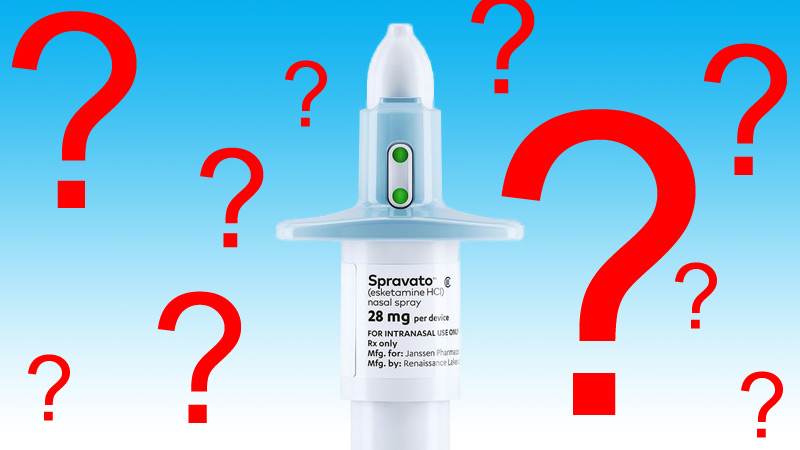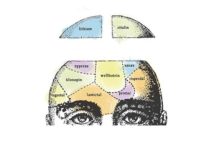In a new article published in The British Journal of Psychiatry, researchers Joanna Moncrieff and Mark Horowitz reviewed the evidence for the use of esketamine for depression. They found a lack of evidence for efficacy and a minimization of the harms of the drug.
“Esketamine has been licensed for ‘treatment-resistant depression’ in the USA, UK, and Europe. Licensing trials did not establish efficacy: two trials were negative, one showed a statistically significant but clinically uncertain effect, and a flawed discontinuation trial was included, against Food and Drug Administration precedent. Safety signals – deaths, including suicides, and bladder damage – were minimized,” Moncrieff and Horowitz write.
 Esketamine—a recently licensed version of the animal tranquilizer and human party drug ketamine—was approved for the treatment of depression in the US, UK, and Europe last year. According to the researchers, “esketamine is twice as potent as ketamine.” Unlike ketamine, which is delivered intravenously, esketamine was formulated as a nasal spray for easy use.
Esketamine—a recently licensed version of the animal tranquilizer and human party drug ketamine—was approved for the treatment of depression in the US, UK, and Europe last year. According to the researchers, “esketamine is twice as potent as ketamine.” Unlike ketamine, which is delivered intravenously, esketamine was formulated as a nasal spray for easy use.
Ketamine is known to cause harmful effects, including bladder damage, heart attacks, and strokes. When used recreationally, it creates a dissociative state in the user, which some find euphoric.
Five trials were submitted to the US FDA in order for the drug company Janssen to receive FDA approval. Three of those trials were short-term randomized controlled trials that pitted esketamine against a placebo nasal spray—and all three lasted only four weeks, shorter than the usual efficacy trials in drug development (the FDA usually requires 6-8 week trials).
The FDA requires at least two efficacy trials to be positive, “each convincing on its own,” in order to approve a new drug. However, in two of the three trials, esketamine was no better than a placebo nasal spray at improving depression symptoms. In the third trial, esketamine was marginally better than the placebo—four points better on a scale that goes to 60 points. This difference is said by researchers to be clinically insignificant—unnoticeable by both patient and doctor.
When Janssen couldn’t meet the requirements for approval of the drug, the FDA made an exception—it allowed the company to submit a “discontinuation” trial as evidence of efficacy. This type of trial has participants who did well on the drug suddenly stop taking it, which often induces withdrawal effects that can mimic depression, among other harmful effects. However, in a “discontinuation” trial, these effects are considered “relapses” and taken as evidence, not of withdrawal, but the drug’s effectiveness.
Perhaps even more concerning is the fact that, within the discontinuation trial, a single site in Poland drove the apparent finding of efficacy. Data from this site suggested that 100% of the placebo group supposedly relapsed (compared with about 33% of the placebo group in all the other sites)—an unlikely result. When data from this suspicious outlier was removed, the study analysis showed no evidence that esketamine was better than the placebo.
Finally, Janssen submitted a safety trial to demonstrate that taking esketamine was not dangerous. In all the trials conducted by Janssen, which included about 1800 patients in the esketamine arm, there were six deaths in the esketamine group. Three were suicides, and two of those occurred in people who had no previous suicidal thoughts. All three suicides occurred just after discontinuing the drug, indicating that they could have resulted from withdrawal effects.
The other three deaths were due to common ketamine effects: one death was a motorcycle accident (which can occur due to dissociation after ketamine use), one was a myocardial infarction, and one was due to acute heart and lung failure. One person experienced a non-fatal cerebral hemorrhage, which is also a known effect of ketamine. Five other people taking esketamine had non-fatal car accidents.
Additionally, more people experienced worsening depression, and more people experienced suicidal thoughts, in the esketamine group than in the placebo group. Because of this, the packaging for esketamine will have to carry the “black box warning” that it may increase suicidality.
About 20% of the participants experienced bladder problems after taking the drug. Half the participants experienced dissociation, and about a third experienced dizziness.
Yet the FDA accepted Janssen’s argument that all of these deaths were unconnected to the drug the participants had all been given. The FDA stated that they could not conclude that even the non-fatal effects were due to the drug, even though all of these effects are commonly observed in users of ketamine.
The UK’s National Institute for Health and Care Excellence (NICE) recommends against esketamine for “treatment-resistant depression” because of the lack of long-term studies and because there is no evidence that the drug is better than existing treatments. However, according to the researchers, NICE should also consider that even the supposed short-term evidence is not convincing and that the harms of the drug have been minimized.
Horowitz and Moncrieff write:
“It would seem that themes from history are repeating: a known drug of misuse, associated with significant harm, is increasingly promoted despite scant evidence of efficacy and without adequate long-term safety studies.”
****
Horowitz, M. A., & Moncrieff, J. (2020). Are we repeating mistakes of the past? A review of the evidence for esketamine. The British Journal of Psychiatry. Published online by Cambridge University Press: 27 May 2020. DOI: https://doi.org/10.1192/bjp.2020.89 (Link)














Thanks Peter.
I see much blame directed at pharma for harm that comes to people. For sure Pharm and the FDA are big partners in crime.
Yet I maintain, ALL doctors are privy to research data. All doctors are aware of the fraudulent papers. They are aware that in fact their patients become guinea pigs.
All doctors have a choice to prescribe, do they not?
It is time for all medical professionals to speak up then. Speak up about the harms and false advertising.
Report comment
I think incessantly and systemically “repeating the mistakes of the past,” but doing it on a more and more massive scale, should be the new mantra of the “mental health system.”
For goodness sakes, when 61-85% of the public will be “diagnosed” with a “mental illness” in their lifetime, that’s ridiculous.
https://www.madinamerica.com/2020/05/12-essential-facts-about-psychiatry/
And the fact that the psychiatric system is killing 8 million people every year, with their “invalid” “mental illnesses,” and neurotoxic drugs. This is downright disgusting.
https://www.nimh.nih.gov/about/directors/thomas-insel/blog/2013/transforming-diagnosis.shtml
https://www.nimh.nih.gov/about/directors/thomas-insel/blog/2015/mortality-and-mental-disorders.shtml
This needs to end, and the psychiatrists should be held accountable for their crimes against humanity, once again.
Report comment
More evidence that the FDA is increasingly a tool of the pharmaceutical industry. What’s discouraging is that both Democrats and Republicans have helped facilitate this deterioration.
Report comment
Isn’t the FDA’s job to get new (patentable) drugs on the market whether or not they actually work the way they’re supposed to? If a new drug gets you buzzed, its commercial potential is so great the public has got to have it.
Report comment
Nice work Peter. Thanks
Report comment
Ketamine causes dissociation and a whole list of side effects. You can’t do a placebo controlled trial when everyone can tell if they got the drug.
Report comment
You make an excellent point!
Plus, people probably DO feel better when they take Ketamine. Until they stop taking it. Or until they become addicted and tolerance builds up. That is not a solution, even if the study WERE really double blinded, and really were positive for Ketamine.
I could do a double blind study for alcohol, and I guarantee that alcohol would show significant anti-anxiety properties. There is no doubt about it. But does that make it a “treatment” for anxiety? It is ancient history that taking substances can alter one’s mental state temporarily. Is this really all that has to be proven for a drug to become a “treatment?”
Report comment
What we have here is Pharma doing what they can to get out another drug of abuse to the public. Something like Purdue did with oxycontin. The manufacturer advises that the dosage be given in the office under supervision. I have already seen one person, an addict, who was able to get a prescription and keep the bottle at home to get a Ketamine high whenever they wanted. I doubt that the manufacturer cares at all about lack of efficacy.
I’m so glad that MIA takes the time to deconstruct the information on these silly drugs, but it is time that pharmaceutical companies need to release all data – all clinical trials, all raw data, everything about who dropped out, etc. We could have this right now if physicians refused to prescribe drugs without proper information. Pharma can call information proprietary to keep it away from physicians, but what happens when physicians won’t prescribe without full information? Unfortunately guild interests of the AMA and APA prevent physicians from doing the right thing.
Report comment
Thank you for your article.
I gather that my comment will not be welcome here, but I must speak, and I find Mad in America contributors to be open-minded and constructively critical. My diagnosis is schizophrenia with depression/anxiety. (I‘ve ‘drained the bath water’ of my personal and collective unconscious, so I don’t have those hallucination concerns like I used to, but that’s a separate story.) But draining the bath water through integration of the unconscious was not able to finally save me from a painful dementia and morbidity. So I have been taking ketamine (not esketamine) for 3-4 months, and it has been life saving and a game changer. Hear me out: I don’t take the nasal spray (way too expensive and fanciful marketed and I don’t have the in office IV’s (inconvenient etc.), but I take a compounded liquid of 15mg per day of normal, classic ketamine. It’s affordable, easy to use, and most importantly has dramatically helped my ‘treatment resistant’ depression and brutal suicidal considerations. I’ve been in this game for over 15 years, and I am not naive. I got the quagmire of pharmaceutical treatment and iatrogenic (treatment induced harm) of drugs, attitudes, and theories. All other antidepressants have been either trivial or with unbearable ‘side effects’, and of course, you have to wait weeks/months to see if they work. This time frame is crazy considering your immediate need for help. I incorporated nutritional supplements (and diet) 8 years ago, and though I made many mistakes, they too have been life transformative to the point where every day was a revelation for a few years. But unfortunately my trauma and abuse, my treatment induced harm from ‘standard’ psychiatry, and years of use and overuse of legal and illegal substances (including tobacco and cannabis, both of which can be medicine if not for their double edge of toxicity and risk of legal punishment), became way too complicated, absurd, appalling, and truly too much.). I’ve informed myself at every stage of this process. I’m in the process of weaning off my major tranquilizer (antipsychotic) and am hopeful for the future. This is partly due to my use of ketamine. It has actually worked. It had an immediate effect that built over a couple weeks. It boosts my mood and actually (and importantly) stimulates my thinking and speech, previously severely crippled. I use to have a gift for language and writing. It has been it’s own revelation. Could my main problem have been depression and not ‘psychosis’? Psychosis is a whole topic in itself. When you’re not writhing in pain and complaining constantly of the mental and physical pain, might it be less ‘necessary’ to sedate yourself into oblivion with tranquilizers? Slow down, silence down, become fatter, sleep more, mute finer details, and then the psychiatrists/physicians think they’ve accomplished something. Now , I might not get to sleep as early with ketamine and I’m sure weaning off it at this point would bring back my suicidal edge of the final abyss (and, really, how much would be withdrawal if the abyss was there prior to use?). I don’t doubt there would be possible withdrawals, but my dose is fairly low. I am thankful every day for it. Please consider all this when you’re trying to paint a comprehensive picture of ketamine (albeit esketamine nasal spray.). BTW, I feel the nasal spray IS another marketing hype to sell an old drug in a new patented, expensive way, and I find it unfortunate and typical of Big Pharma. Will you take my ‘anectdotal’ report in to your examination? I hope so. Thank you. I love Mad in America, even though I don’t agree with everyone on everything (who does?), and I plan to publish my paper on Jungian psychology, schizophrenia, hospitalization, and times of crisis.
Report comment
Your comment is very welcome, and thanks for sharing it!
Report comment
Thank you evanhaar.
It’s nice to read your post. And I’m glad that you listen to your own body.
I especially like the fact you describe yourself and what works for you through your
own knowledge, your experiences, about yourself and not as a “universal disease”
I’m glad you love MIA and support it.
Looking forward to your writing.
Report comment